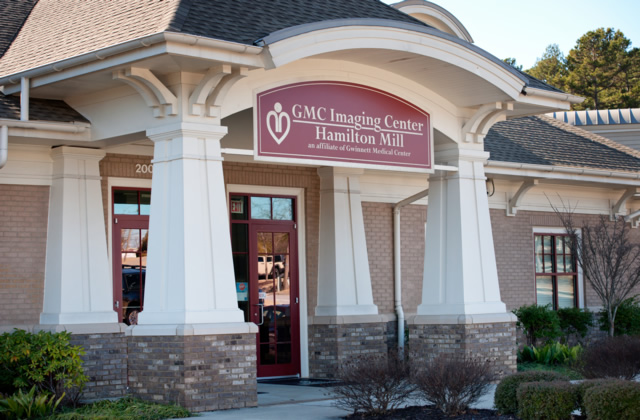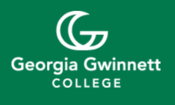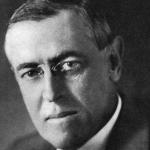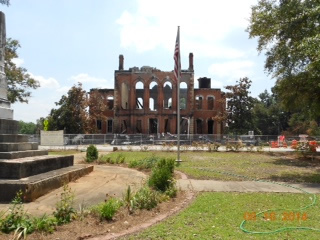
EXPANSION: Gwinnett Medical Center has announced further expansion of services at its Hamilton Mill location, across from the Duncan Creek Public Library in Hamilton Mill Station. Services now include primary care, cardiac and women’s services and walk-in care. Patients can also get imaging services, including mammograms, x-ray and ultrasound, at this location.
Issue 14.89 | Feb. 13, 2015
IN THIS ISSUE
TODAY’S FOCUS: This Year To Be 10th Anniversary of Georgia Gwinnett College
EEB PERSPECTIVE: Georgia State University Once Seen as University System Step Child
ANOTHER VIEW: We Live in Fear, Hope and Complacency
FEEDBACK: More about Bus Driver Insurance, And Three More Letters
UPCOMING: Byerly Returns to Gwinnett Tech; Snellville Charitable Event; Lecture Series
NOTABLE: County Closes on Simpsonwood Property; Jenkins Joins Gwinnett Tech Board
GEORGIA TIDBIT: Woodrow Wilson Becomes Academic, Politician, Then President
TODAY’S QUOTE: Wisdom from Eleanor Roosevelt
MYSTERY PHOTO: Several Spotted the Bonneville Salt Flats
LAGNIAPPE: PCOM Pharmacy Students Working with Patients
TODAY’S FOCUS
Georgia Gwinnett College Kicks Off Activities Marking 10th Anniversary
By Sloan Jones
LAWRENCEVILLE, Ga., Feb. 13, 2015 — In January of 2005, Senate Resolution 33 “….approving the creation of a new four-year college in Gwinnett County by the Board of Regents of the University System of Georgia,” began moving through the legislative process. On May 10, 2005, then-Governor Sonny Perdue put pen to paper, creating an institution that soon would be named Georgia Gwinnett College.
Today, when the gavel sounded the opening of the legislative day, Georgia Gwinnett students and administrators were there to kick-off the institution’s 1th anniversary celebration.
Resolutions recognized that GGC is the first four-year college founded in the 21st Century as well as the fact that the institution has gone from zero to nearly 11,000 students since its founding.
 GGC President Stas Preczewski maintains that to say that Georgia Gwinnett College is a dynamic institution is an understatement. “Over the course of just 10 short years, GGC built upon the efforts of a handful of strong visionaries to establish what has become a nationally recognized, innovative model for 21st century higher education. From the beginning, GGC was deliberately progressive and took strategic steps that now uniquely define our future.”
GGC President Stas Preczewski maintains that to say that Georgia Gwinnett College is a dynamic institution is an understatement. “Over the course of just 10 short years, GGC built upon the efforts of a handful of strong visionaries to establish what has become a nationally recognized, innovative model for 21st century higher education. From the beginning, GGC was deliberately progressive and took strategic steps that now uniquely define our future.”
GGC is ethnically and intellectually diverse. The college literally was built from the ground up to facilitate individual student success – no matter the level of academic preparation, learning style, work schedule or financial barrier. The success of individual GGC students and their families translates into success for the area.
Now the ninth largest college in the Atlanta area and still the fastest growing institution in the state, GGC places student enhanced learning experiences and college completion at the core of its mission. A world-class teaching and mentoring faculty coupled with strong student support initiatives fuel the culture of student engagement that has quickly become the GGC hallmark.
Preczewski adds: “Georgia Gwinnett is not just about numbers and growth, but it is about the lives that have been transformed through an educational institution that has grown up alongside its students, A product of Gwinnett County for Gwinnett County and the region, GGC was created by those who knew best the needs of its citizens and its economy. This celebration will serve as the perfect transitioning point as we move from a growth model to a sustainment model. We are launching a strategic planning process that will shape the institution as it nears its enrollment cap of 13,000.”
GGC has changed the educational landscape in Gwinnett County and beyond. A reflection of this vibrant and progressive region, GGC recently was recognized by U.S. News & World Report magazine as the most ethnically diverse college in the South, among both public and private colleges.
GGC has brought affordable and convenient educational opportunities to the highly populated Gwinnett region. The college’s tuition rate of $118 per credit hour is lower now than when the college opened its doors. USN&WR recognized GGC as having the lowest in-state tuition and fees among ranked public colleges for 2014-15. Its access mission has made higher education possible for many students who otherwise would not have this opportunity.
“This college’s unique mission and vision will continue to transform lives, families and communities for generations to come,” says Preczewski.
EEB PERSPECTIVE
Georgia State University Was Once a Stepchild of University System
By Elliott Brack, editor and publisher, GwinnettForum.com
(First in a series of three reports)
FEB. 13, 2015 — Now that the Board of Regents have decided to merge Georgia State University with Georgia Perimeter College, GSU will soon total more than 50,000 students, and will be the largest unit of the University System of Georgia. Not only that, but it is an urban university, as well as a research university, bringing in $58 million in 2011 in grants for study. It has conferred 192,785 degrees since its founding.
That’s a long way from its start in 1913 as the evening school of Georgia Tech, which administered the program until 1933. Then for years it was almost invisible before coming under auspices of the University of Georgia.
GSU’s life under UGA was a rough ride, as UGA officials did not want the Atlanta campus to distract from the flagship university in Athens. For many years, the Athens administrators worked tirelessly to keep the Atlanta campus from growing and thriving. Yet it seemed no matter what, the Atlanta campus kept adding students and growing in importance.
It all began with 44 students in 1913. By 1940, it had 3,000 students; was up to 8,000 in 1955, 13,000 in 1960, and more than 30,000 students in 2009. Many people came to Atlanta for a job, enrolled in night courses to improve themselves, gained a degree, and got a better job.
One person who had a first-hand knowledge of what went on in the formative days of GSU is Dr. Paul Kolter, 93, who is retired today in Sandy Springs. He first came to GSU in 1952, teaching biology, anatomy, zoology and other sciences. He was originally from Ohio, served in World War II, got two degrees from Maryville College and his Ph.D. from Emory.
“I was making $2,400 for nine months teaching at Maryville. Georgia State offered me $3,300 for nine months, so I came. Every summer I taught for extra money.
“Back then, the Athens campus controlled us tightly. I ev
en had to send my test papers to Athens to have them graded. They treated us like step-children.”
When Dr. Kolter came to GSU, the entire faculty and staff (down to janitors) “…totaled 85 people. We only had about 3,000 students then. We knew everyone. We didn’t have much money for operations. They promised me a raise, saying they would try to give me $50 a year more, and several years later, they did.”
Georgia State had problems with space, Dr. Kolter continues: “Finally George Sparks, who directed the school and did more for the school than anyone else, got a former parking garage on Ivy Street for us, and we taught classes there in Kell Hall. It still had the ramps for automobiles, and old elevators. Many people used the ramps to get to class, since it was faster. George found all sorts of surplus equipment for the college from the military bases and from the Bell Bomber plant in Marietta. I remember one classroom where we had mix-matched doors, all different. But we at least had a place to teach.”
There was no doubt that George Sparks was the key to the school. “He scrimped and saved, and even put in Coke and candy machines, and used that money for operations. He bought buildings on Decatur Street, including a black theatre, and that’s where Georgia State has expanded so much today.”
Much of the problems between GSU and UGA, nearly a feud, has been chronicled by Dr. Merl E. Reed in the Georgia Historical Quarterly in 1996.
* * * * *
COMING SOON: More on the acrimony between Georgia State and UGA.
Timeline, Ga. State University Formation
- 1913: Began as Evening School of Georgia Tech Commerce School, with 44 enrollees.
- 1917: Women admitted because of decline in male students in WWI.
- 1920: Enrollment up to 364.
- 1932: Director George Sparks promotes arts and sciences; sees school as major institution.
- 1933: University System of Georgia created; removed Evening School from Georgia Tech. Operated under USG as “Atlanta Center.”
- 1935: Became three year business school, but lacked accreditation.
- 1940: Operated as University of Georgia Center in Atlanta. 3,000 students.
- 1947: Merged under UGA as Atlanta Center. Difficulties with operation under UGA.
- 1952: Gains SACS Accreditation.
- 1955: Regents create Georgia State College of Business Administration. 8,000 students.
- 1957: Noah Langdale becomes president, pushes for expansion.
- 1958: GSU Foundation established, to gain more financial support.
- 1962: Name changed to Georgia State College.
- 1969: With 13,000 students now, becomes Georgia State University
- 1982: GSU gains law school.
- 1992: Carl Patton becomes president, defines mission as research institution.
- 2009: Mark Becker becomes president. Up to 30,000 students.
- 2014: Regents plan to merge Georgia Perimeter College with GSU, to have 54,000 students, and be largest unit of University System.
ANOTHER VIEW
We Live in Fear, Hope and Complacency, but Also Stir in Some Media
By George Wilson, contributing columnist
 FEB. 13, 2015 — We have two dominate political parties in this country. One panders to fear, i.e., the immigrants will bring Ebola across the border, ISIS will invade us, etc. Also, entitlements need cuts or we will bankrupt the country with deficit spending. Or I’m afraid the government will confiscate my guns despite thousands gunned down annually. That is why we need to increase defense spending, curtail a few freedoms, do a little torturing and have a tax cut for the top 1 percent.
FEB. 13, 2015 — We have two dominate political parties in this country. One panders to fear, i.e., the immigrants will bring Ebola across the border, ISIS will invade us, etc. Also, entitlements need cuts or we will bankrupt the country with deficit spending. Or I’m afraid the government will confiscate my guns despite thousands gunned down annually. That is why we need to increase defense spending, curtail a few freedoms, do a little torturing and have a tax cut for the top 1 percent.
The other offers hope, a measured intelligent response to world problems, health insurance for everyone, a decent wage for all workers, re-building the nation’s infrastructure. A superior education with a decrease in the cost of financing would cement this all together. Finally, work to build a sustainable planet and with all of the above, joblessness in this country would be eliminated.
Finally, we have the one that belongs to the average voter, complacency. As an example, do a test on your friends or relatives. Ask them to name their elected representatives from the President to the local sheriff. I rest my case, because very few, if any, can accomplish this simple test of living in a democracy.
So, we have the three, fear, hope and complacency and now stir in the incompetent, monopolist media, principally cable television and right-wing talk radio shows. Also make an analysis of the local nightly news. What we see is gun violence and killings; one right after the other. Finally, remember the fear factor above, the emphasis is always on African-Americans doing the crime. This gets those ratings up and adds profits to the bottom line.
Now we are cooking, so add unlimited spending by the oligarchy or corporate elite on elections and extensive gerrymandering. What is the final product? Perhaps civil unrest, an increase in crime, or other negative things could be in our country’s future.
IN THE SPOTLIGHT
Gwinnett County Public Library
 The public spiritedness of our sponsors allows us to bring GwinnettForum.com to you at no cost to readers. The Gwinnett County Public Library (GCPL) is proud to serve the Gwinnett community with a newly updated catalog that will allow library users to better discover and access the library’s collection. The library is a public community partner that supports economic development with early literacy opportunities, curriculum support, and lifelong learning based programs for all residents. In addition to remote resources like the innovative AskGCPL service, GCPL provides wireless internet access and public computers in each branch. Learn more about the library at www.gwinnettpl.org.
The public spiritedness of our sponsors allows us to bring GwinnettForum.com to you at no cost to readers. The Gwinnett County Public Library (GCPL) is proud to serve the Gwinnett community with a newly updated catalog that will allow library users to better discover and access the library’s collection. The library is a public community partner that supports economic development with early literacy opportunities, curriculum support, and lifelong learning based programs for all residents. In addition to remote resources like the innovative AskGCPL service, GCPL provides wireless internet access and public computers in each branch. Learn more about the library at www.gwinnettpl.org.
FEEDBACK
Angered by Efforts by the Governor To Cut Bus Drivers’ Insurance
Editor, the Forum:
 As a retired educator and the parent of a Gwinnett County Public Schools food service employee, I was so angered by Gov. Nathan Deal’s plan to halt insurance for the part time workers. These are the people who truly make the system run so teachers can attempt to teach. There is so much paper work and test passing pressure that teaching is secondary. But that is a rant for another day.
As a retired educator and the parent of a Gwinnett County Public Schools food service employee, I was so angered by Gov. Nathan Deal’s plan to halt insurance for the part time workers. These are the people who truly make the system run so teachers can attempt to teach. There is so much paper work and test passing pressure that teaching is secondary. But that is a rant for another day.
Many of the part-time employees work primarily for the insurance and benefits. It certainly isn’t for the huge paychecks. Some of these people are retired, raising children, attending post-secondary school, or like my son, slightly handicapped. The benefits makes their lives much richer and reduces a lot of stress.
When your take-home pay is less than $450 to, the most experienced, at $600 a month, and Obama care Insurance with the drug plan running well over $100, life gets harder. The insurance through the State Health Benefit Plan may not always be to our liking, but it is good coverage. The fact that you are in a group of thousands means that the employee gets much better plans and prices. Yes, the various school systems do pay a portion of the insurance premium. Yes, they take credit for it and I bet you won’t get that money in your pay packet if the insurance for part-timers is removed.
Could a school run without bus drivers, food service workers, part time clerical staff, part time para-professionals, part-time janitorial and all of the other less than 30 hours a week employees? It probably would. Would the quality of the buildings, student learning, teacher and student moral be negatively affected. You bet.
— Marlene Ratledge Buchanan, Snellville
Ooops! That Was Two Different Bridges in the Last Edition
Editor, the Forum
While Ruthy Lachman is correct that the Kurushima-Kaikyo Bridge is the longest suspension bridge in the world, it is located in Japan. You’ll notice from the picture of the Kurushima-Kaikyo Bridge below that the towers have two horizontal cross bracings above the roadway deck, while the foreground bridge in the mystery photo has three.
— Rich Edinger, Lawrenceville
Feels Forum’s Opinion Was Excellent Summary of Governor’s Efforts
Editor, the Forum:
Your recent take on Governor Deal was an excellent summary of our “beloved” governor. His legacy, so far, anyway, is that of cronyism, obstructionism, and an ever-present willingness to kick the working folks while they’re down. I’ll stand by my name for him, that is, Shady Deal.
— Robert Hanson, Loganville
Took Up Forum Suggestion and Enjoyed Jamaican Restaurant in Lilburn
Editor, the Forum:
After reading the article in GwinnettForum on the new Jamaican restaurant, “A Taste of Paradise” in Lilburn, I decided I needed to try the exotic sounding menu. On Wednesday at lunch a companion and I dined at Paradise. Now while I dislike highly spiced food, it can never be too spicy for my friend, so this seemed like the perfect opportunity for a fair and balanced review. We both loved our individual selections.
I had oxtail and my friend had jerk chicken, both as lunch plates. Not sure how either of us could have eaten more, as these was very generous servings. We both were more than satisfied. They also gave us another taste of other chicken and beef dishes and they were excellent also. Desserts looked delicious but we were too full to try them. I will return, and highly recommend this restaurant to everyone.
— Steve Rausch, Peachtree Corners
UPCOMING
Byerly Returns to Gwinnett Tech as VP of Institutional Advancement
Mary Beth Byerly is returning to Gwinnett Technical Collage as the vice president of institutional advancement. She will also serve as the executive director of the Gwinnett Tech Foundation. Byerly most recently was director for resource development for the Technical College System of Georgia.
As vice president of institutional advancement, Byerly will oversee the college’s marketing and communications and the activities of the Gwinnett Tech Foundation including all resource development initiatives, scholarships and alumni activities.
Byerly first joined Gwinnett Tech in 2000. She had major roles in the development of the George Busbee International Center for Workforce Development, the D. Scott Hudgens, Jr. Early Education Center and the Life Sciences Center.
Prior to joining Gwinnett Tech, Byerly worked for 12 years with the United Way of Greater Atlanta. She graduated from Georgia State University with a degree in business administration. Byerly is also a graduate of Leadership Gwinnett.
Snellville Planning Third Casino Night To Benefit Local Charities
Donations and sponsorships are being sought for the third annual Casino Night, sponsored by The Gwinnett Sunrise Rotary Club, the Snellville Tourism and Trade Association and the Greater Eastside Chamber of Commerce. This year the three civic organizations are banding together to raise money for The Snellville Community Garden, The Gwinnett Community Clinic and other local charities.
The event will take place from 6 to 10 p.m. on March 14 at Summit Chase Country Club, 3197 Classic Drive. Table sponsorships are available. Business owners may also donate silent auction and/or raffle items.
Admission is $40 per person and includes a buffet, a complimentary drink ticket and $15,000 in play money for table play. A cash bar is also available. Bids on silent auction items can be made throughout the evening with final bids from 9: 15 to 9:30 p.m. Raffle prizes will be announced from 9:30 through 10 p.m.
For information about sponsorship opportunities or to donate silent auction and/or raffle items, contact Jamey Toney at jtoneyuga@gmail.com or 678-758-3288. For information about Casino Night, to make reservations, visit www.snellvilletourism.com.
Brenau Sponsors Third Annual Lecture Series This Weekend
Brenau University, in partnership with Gainesville First Baptist Church, Grace Episcopal Church, and other local churches serving Northeast Georgia, will sponsor the 2015 Annual Religion for the 21st Century Lecture Series Friday, on February13, at 7 p.m., and Saturday, February 14, 10 a.m. and 1:15 p.m. at the Brenau Downtown Center, 301 Main St. The two-day Chautauqua-style event will include three lectures, coffee and water service, a reception, and on-site lunch. This year’s lectures are entitled “Sibling Rivalry: Biblical Stories, Modern Interpretations.”
Keynote speaker Professor Amy-Jill Levine currently holds the E. Rhodes and Leona B. Carpenter Professorship of New Testament Studies and Jewish Studies at Vanderbilt University and is a member of Cambridge University’s Woolf Institute: Centre for the Study of Jewish-Christian Relations.
This will be the third Religion for the 21st Century lecture program sponsored by Brenau University and Gainesville Churches. For more information or to register online visit http://brena.us/1z5nX8b.
NOTABLE
County Closes on $14 Million Purchase of Simpsonwood Property
Gwinnett County has closed on the $14 million purchase of Simpsonwood from the North Georgia Conference of the United Methodist Church. The 223-acre property is located in Peachtree Corners. Funded by SPLOST, the Simpsonwood acquisition provides an opportunity to preserve green space and provide passive recreational opportunities for residents of Gwinnett.
The Simpsonwood property is predo
minantly forested with hardwood and evergreen trees with approximately 2,140 linear feet of river frontage along the Chattahoochee River. A timeline has not yet been established for planned improvements to the park property. The first step in the process is to develop a park master plan, which is anticipated to begin within the year.
Gwinnett Tech Adds Doug Jenkins to Its Board of Directors
Gwinnett Technical College has expanded its board of directors with the addition of Doug Jenkins, Metro North Region Manager for Georgia Power. Jenkins is responsible for providing leadership for region operations, sales, customer service, economics and community development. He is also responsible for external affairs activities for 327,000 Georgia Power customers in Gwinnett, Forsyth, North Fulton and North DeKalb. Prior to his current position, he served as assistant to the executive vice president of customer service and operations and got a master’s degree in finance from Georgia State. He joined Georgia Power in 1987 as a co-op student at Georgia Tech, where he earned a bachelor’s degree in electrical engineering. He is also a member of the Gwinnett County Public Schools Foundation.
GEORGIA ENCYCLOPEDIA TIDBIT
Wilson Becomes Academic, Politician, Then President
(Continued from previous edition)
In June, 1983, Woodrow Wilson spent time in Rome with his uncle, James W. Bones, in settling the estate of another uncle. There he met Ellen Louise Axson, the daughter of the Reverend Samuel Edward Axson and Margaret Jane Hoyt. After a brief courtship Wilson persuaded Ellen Axson to marry him, but not until he decided to give up the practice of law and returned to school at Johns Hopkins University in Baltimore, Md., where he received a Ph.D. in 1886. Meanwhile, she attended the Art Students League of New York. Wilson and Axson married in Savannah on June 24, 1885, in the manse of the Independent Presbyterian Church, the home of Axson’s grandfather.
In the 1880s Wilson’s career as a teacher took him to Bryn Mawr College in Pennsylvania, followed by a stint at Wesleyan University in Middletown, Conn. He went to Princeton University in 1890 as professor of jurisprudence and was appointed president of that institution in 1902. After his resignation in 1910, he was elected governor of New Jersey as a Democrat, serving in 1911 and 1912. He was the Democratic candidate for president in 1912 and was elected over incumbent William Howard Taft and former president Theodore Roosevelt, who had split the Republican vote. He served two terms, from 1913 to 1921.
Ellen Wilson, who suffered from kidney disease, died on August 6, 1914, 17 months after her husband became president. She is buried in Rome, at Myrtle Hill Cemetery. Wilson was remarried in December 1915 to Edith Bolling Galt. Wilson died in Washington, D.C., on February 3, 1924, and is buried in a crypt in the Washington National Cathedral.
THOUGHT OF THE DAY
Live With Curiosity and Stay Alive
“Life was meant to be lived, and curiosity must be kept alive. One must never, for whatever reason, turn his back on life.”
— Former First Lady Eleanor Roosevelt (1884-1962).
MYSTERY PHOTO
Brick walls may be a clue
CLUE: No, this is not the Bona Allen Tannery Warehouse, which burned this week in Buford. But what do these brick walls tell us about this place? Try to figure it out and send your idea to elliott@brack.net and be sure to include your hometown.
 Though we got some strange guesses, last edition’s mystery photo was the Bonneville Salt Flats in Utah, taken by Donnie Loeber, who is based in Norcross. First in with the right answer was Jane Bane of Buford.
Though we got some strange guesses, last edition’s mystery photo was the Bonneville Salt Flats in Utah, taken by Donnie Loeber, who is based in Norcross. First in with the right answer was Jane Bane of Buford.
Others getting it right were Bob Hanson of Loganville, Mark Barlow of Peachtree Corners, Logan Duke, Atlanta; Susan McBrayer, Sugar Hill; Karen Garner, Dacula; Roy Holman, Snellville; Lou Camerio, Lilburn; and Mike Sweigart, Duluth.
LAGNIAPPE
Caring for patients
This January, Philadelphia College of Osteopathic Medicine pharmacy students prepared diabetes care packages to benefit patients at local, underserved medical clinics. One of these clinics, the Good Samaritan Health Center of Gwinnett in Lawrenceville, is a nonprofit health clinic that serves uninsured members of the community. Each year, Walgreens awards money to student organizations on campus. This year, student leaders decided to combine these funds to make a bigger impact on the community, especially patients living with diabetes. From left are Tenicia Talley Executive Director Greg Lang of Goods Samaritan Center; April Lawson Cierra and Andrea Douglas.
CREDITS
GwinnettForum is provided to you at no charge every Tuesday and Friday. If you would like to serve as an underwriter, click here to learn more.
- MORE: Contact Editor and Publisher Elliott Brack at: elliott@gwinnettforum.com
UNSUBSCRIBE
We hope you’ll keep receiving the great news and information from GwinnettForum, but if you need to unsubscribe, click here.
© 2015, Gwinnett Forum.com. Gwinnett Forum is an online community commentary for exploring pragmatic and sensible social, political and economic approaches to improve life in Gwinnett County, Ga. USA.
















Follow Us